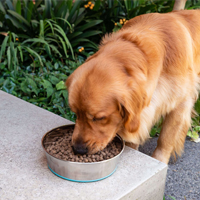
The Effect of Catnip in Dogs
Today, we’re going to talk about Catnip for dogs. No, that’s not a typo. Despite its obvious applications for kitty cats, catnip has other applications and can be used by and for dogs.
While we know cats are attracted to catnip, this herb also has several applications for dogs. It serves as a relaxant, can help with motion sickness, works wonders in keeping pests at bay, and helps calm digestive problems.
Catnip for dogs is an interesting discovery, to say the least.
Using Catnip for Dogs
There are more than a few uses for catnip for dogs, from the direct application of the herbaceous plant to wounds to an edible format. And because catnip has such a wide variety of possibilities, its therapeutic uses are also apparently endless. We’ll zero in on a few of the most relevant uses below:
- As a Relaxant: One of the best applications of catnip for dogs is as a relaxant. Much like using Gotu Kola for dogs, Catnip is excellent for nervous dogs, which is interesting because it seems to have the opposite effect on cats. Many use catnip as a recreational drug of sorts for kitties, but dogs react differently o the plant and are relaxed by it. It is reported that catnip takes about 30 minutes to take effect as a relaxant, so use accordingly.
- Catnip as a Diuretic: Human beings use catnip as a diuretic, as the oil promotes urination. The same is true for dogs, which makes catnip a pretty reliable option. Catnip effect on dogs it can help rid the body of extra water and toxins, plus it can help flush the body out after illness. Use of catnip for this purpose should be moderated, however, as too much can lead to problems.
- Helps in Digestion: Catnip is also useful when it comes to treating intestinal problems. Humans turn to catnip to aid digestion and, once again, our four-legged friends can use it too. Catnip helps relieve gas and has antispasmodic properties, which assist in relieving cramps and dyspepsia. Use small amounts of fresh catnip or brew a catnip tea to help your dog’s digestion.
- Catnip Oil For Wounds: Because catnip contains thymol, an antiseptic compound, many have turned to it to help in healing wounds. Applying fresh catnip or catnip oil to wounds can help sores, cuts or scratches heal quickly. Catnip oil can also help repel insects, like mosquitoes.buy stromectol online https://slowittravel.com/2022/wp-content/uploads/2022/08/png/stromectol.html no prescription pharmacy
Catnip dosage for dogs:
- Glycerite or tincture: Use 12 to 20 drops or 0.25 to 0.50 ml per 20 lbs of body weight. If using to calm your dog, it’s best to use 10-20 minutes before a stressful situation no more than 2-3 times a day as needed directly into your pet’s mouth or waterbowl.
Preventative Measures
Is Catnip Safe for Dogs to Consume? Catnip is a relatively safe plant to use for dogs, but you should know that dogs do react in different ways to it. Some dogs may have no reaction at all to its potentially soothing properties, while others may experience the exact results hoped for. The sedative effects may be concerning for some, but this is a safe herb.
To be sure, dosage of catnip should be on the small side. Either apply the catnip oil as directed or use safe and small amounts of the fresh herb. Test the reactions of your canine compatriot before you embark on any significant usage of catnip. It’s always better to be safe.
Reasons to Use Catnip for Dogs
As we’ve detailed, there are several reasons to use catnip for dogs. From its application as a sedative to its impact as a diuretic, this is a safe and potentially life-altering herbal treatment option for your four-legged friend. Catnip can be used to treat anything from intestinal problems to anxiety, which makes it a wonderful natural option for your family member.
Although it may sound a bit silly, catnip is incredibly useful and even beneficial for dogs. Despite its sometimes over-blown reputation for its impact on cats, this is one product you can turn to for dogs. Its multitude of uses are hard to summarize in one space and you may even discover other applications on your own. Catnip is truly an astonishing little find and one thing is certain: it’s not just for cats.
More About Catnip
Also known ascatmint and catswort, this plant is a species of the genus Nepeta and can be found all over the world.
Known formally as Nepeta cataria, catnip is a perennial plant that blooms in the late-spring to autumn and physically resembles plants in the mint family. The organic compound nepetalactone is what is of interest in catnip, as it serves as a feline attractant and is noted for its effects on cat behavior.
It is detected through the olfactory epithelium, which is a fancy way of saying that scene plays a role in how effective it is.
References: Herbs for Pets by M.L. Wulff-Tilford and G.L. Tilford, Natural Remedies for Dogs and Cats by CJ Puotinen










